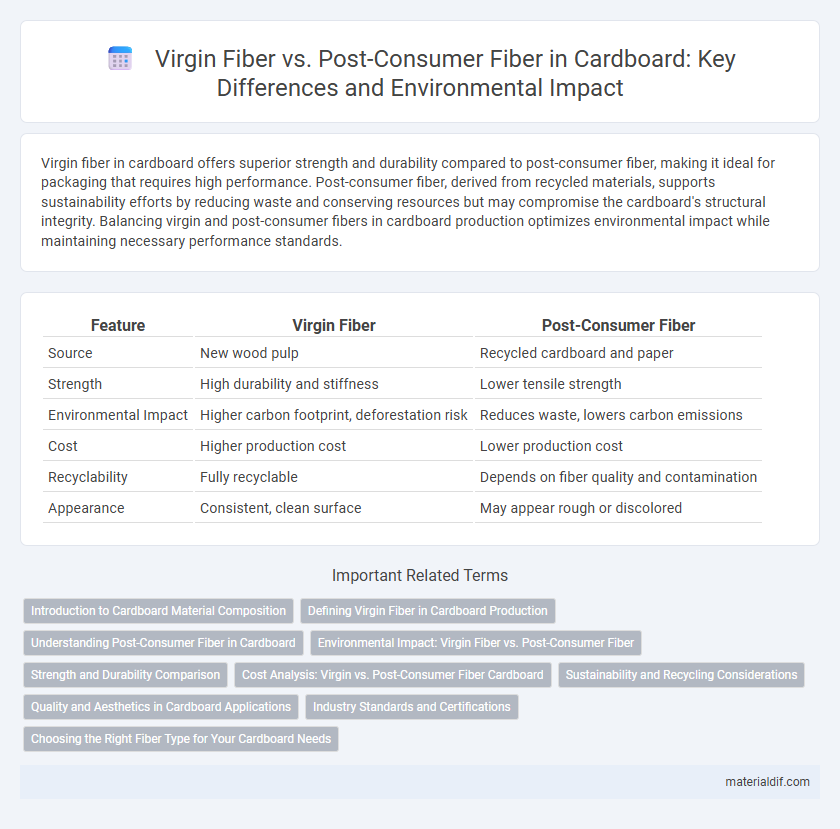Virgin fiber in cardboard offers superior strength and durability compared to post-consumer fiber, making it ideal for packaging that requires high performance. Post-consumer fiber, derived from recycled materials, supports sustainability efforts by reducing waste and conserving resources but may compromise the cardboard's structural integrity. Balancing virgin and post-consumer fibers in cardboard production optimizes environmental impact while maintaining necessary performance standards.
Table of Comparison
| Feature | Virgin Fiber | Post-Consumer Fiber |
|---|---|---|
| Source | New wood pulp | Recycled cardboard and paper |
| Strength | High durability and stiffness | Lower tensile strength |
| Environmental Impact | Higher carbon footprint, deforestation risk | Reduces waste, lowers carbon emissions |
| Cost | Higher production cost | Lower production cost |
| Recyclability | Fully recyclable | Depends on fiber quality and contamination |
| Appearance | Consistent, clean surface | May appear rough or discolored |
Introduction to Cardboard Material Composition
Cardboard primarily consists of two types of fibers: virgin fiber and post-consumer fiber, each impacting durability and sustainability differently. Virgin fiber, derived from fresh wood pulp, offers higher strength and stiffness, making it ideal for packaging that requires superior protection. Post-consumer fiber, recycled from used paper products, enhances environmental benefits by reducing waste but may compromise structural integrity in heavier-duty applications.
Defining Virgin Fiber in Cardboard Production
Virgin fiber in cardboard production refers to fibers sourced directly from freshly harvested wood, ensuring maximum strength and purity. This type of fiber offers superior durability and structural integrity compared to recycled alternatives, making it ideal for packaging that requires high load-bearing capacity. Using virgin fiber also reduces contaminants, which improves the quality and appearance of the final cardboard product.
Understanding Post-Consumer Fiber in Cardboard
Post-consumer fiber in cardboard refers to recycled paper fibers sourced from products that consumers have used and discarded, offering an eco-friendly alternative to virgin fiber. This type of fiber reduces the need for fresh wood pulp, conserving natural resources and lowering carbon emissions during production. Incorporating post-consumer fiber maintains board strength and durability while promoting sustainability in cardboard manufacturing.
Environmental Impact: Virgin Fiber vs. Post-Consumer Fiber
Virgin fiber, derived directly from trees, generally has a higher environmental impact due to deforestation, increased water consumption, and energy use in processing. In contrast, post-consumer fiber is sourced from recycled cardboard, significantly reducing landfill waste, conserving natural resources, and lowering carbon emissions associated with raw material extraction. Utilizing post-consumer fiber in cardboard production promotes sustainability by minimizing ecological footprints and supporting circular economy principles.
Strength and Durability Comparison
Virgin fiber in cardboard offers superior strength and durability due to its longer, unbroken fibers, which provide better structural integrity and resistance to wear and tear. Post-consumer fiber, composed of shorter and more processed fibers, typically results in cardboard with reduced tensile strength and less durability over repeated use. The choice between virgin and post-consumer fiber directly impacts the performance of cardboard in packaging and shipping applications where strength is critical.
Cost Analysis: Virgin vs. Post-Consumer Fiber Cardboard
Virgin fiber cardboard typically incurs higher production costs due to raw material extraction and intensive processing, whereas post-consumer fiber cardboard benefits from lower material expenses by utilizing recycled content. Despite slightly higher processing requirements for cleaning and sorting, post-consumer fiber cardboard offers significant cost savings and environmental benefits. Market demand and quality constraints influence the price gap, with post-consumer fiber becoming increasingly competitive in cost-effectiveness for sustainable packaging solutions.
Sustainability and Recycling Considerations
Virgin fiber in cardboard provides superior strength and durability but requires greater resource consumption and energy input, impacting sustainability negatively. Post-consumer fiber significantly enhances recycling efforts by reducing landfill waste and conserving natural resources, though it may compromise the material's strength and quality. Emphasizing the use of post-consumer fiber supports circular economy principles and lowers carbon footprint in cardboard production.
Quality and Aesthetics in Cardboard Applications
Virgin fiber in cardboard offers superior strength, brightness, and uniformity, making it ideal for high-quality packaging with excellent printability and visual appeal. Post-consumer fiber, while more sustainable, often contains contaminants and shorter fibers that can compromise durability and result in a duller surface finish. Selecting virgin fiber enhances cardboard aesthetics and structural integrity, crucial for premium applications requiring crisp graphics and robust performance.
Industry Standards and Certifications
Virgin fiber in cardboard production adheres to industry standards such as FSC (Forest Stewardship Council) certification, ensuring sustainable sourcing from responsibly managed forests. Post-consumer fiber often meets SFI (Sustainable Forestry Initiative) and PEFC (Programme for the Endorsement of Forest Certification) standards, validating recycled content and environmental impact reduction. Certifications like ISO 14001 for environmental management are increasingly applied across both virgin and post-consumer fiber, promoting compliance with global sustainability criteria.
Choosing the Right Fiber Type for Your Cardboard Needs
Virgin fiber offers superior strength and durability, making it ideal for packaging that requires high performance and protection. Post-consumer fiber is an eco-friendly alternative that reduces environmental impact by recycling used materials, suitable for less demanding applications. Selecting the right fiber type depends on balancing structural requirements with sustainability goals to optimize both functionality and environmental responsibility.
Virgin fiber vs Post-consumer fiber Infographic

 materialdif.com
materialdif.com